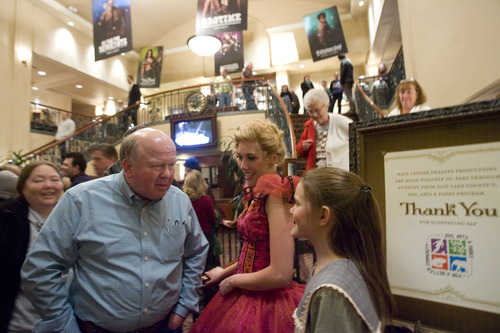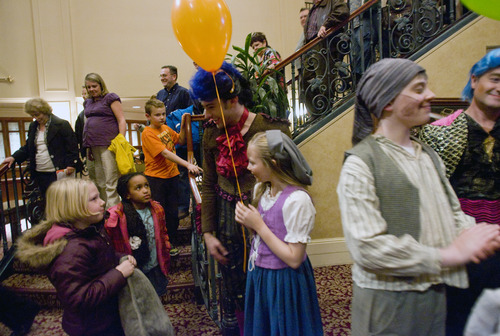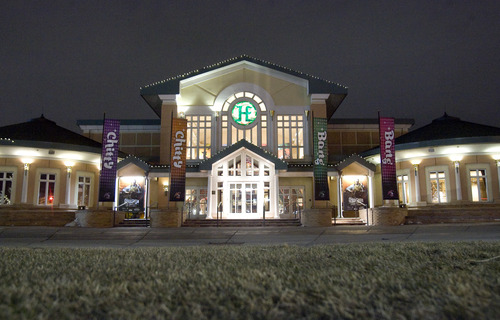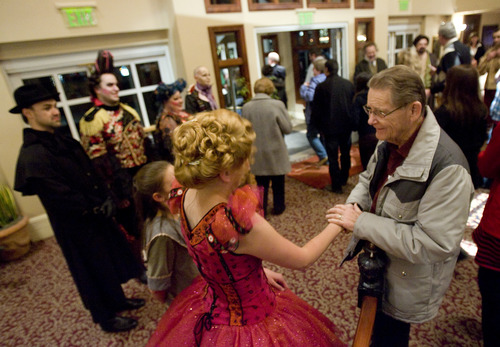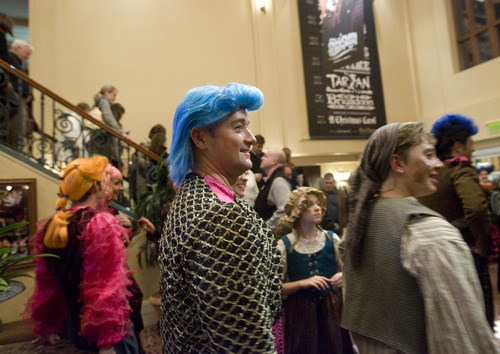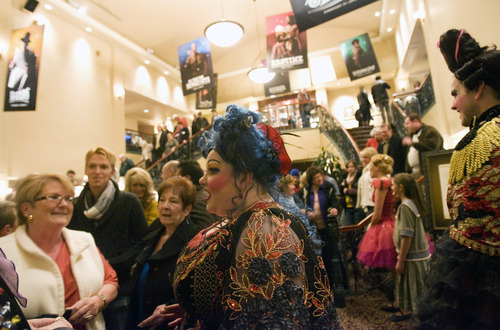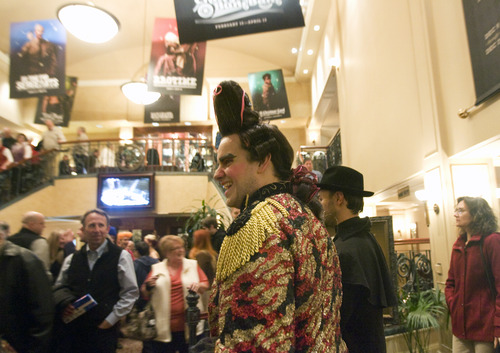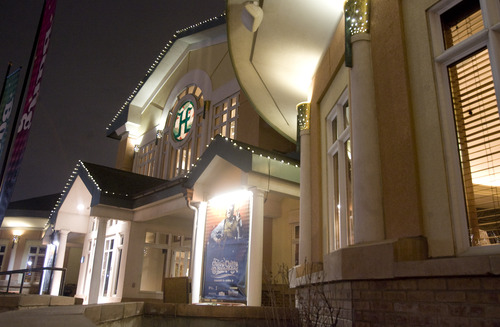This is an archived article that was published on sltrib.com in 2013, and information in the article may be outdated. It is provided only for personal research purposes and may not be reprinted.
No one ever has accused Hale Centre Theatre of stage fright.
With origins stretching back more than 60 years to the Mormon meetinghouse productions of founders Nathan and Ruth Hale, the theater has moved through various scenes and second acts, seemingly without intermission. Today, it's the most successful community theater in the United States, both in terms of ticket sales and annual operating budget.
"They call us the theater from Mars," Sally Dietlein, the theater's vice president and chief administrative officer, told The Salt Lake Tribune last March, when the theater announced plans to expand its facility. "Audiences are dying out, but not in Utah.
Hale Centre Theatre's current West Valley City playhouse averages more than 400 live shows a year — a remarkable schedule that rarely leaves the theater dark.
There's real drama in the theater's fiscal story, too. Namely, the extraordinary salaries of its top administrative staff, matched with a prowess that's earned the nonprofit arts organization an annual largesse of taxpayer funds.
The company's 2011 tax records show that theater president Mark Dietlein, grandson to founder Ruth Hale, reported $150,996 in income that year, plus $15,000 in additional compensation for his retirement account. Wife Sally Dietlein, the theater's vice president, received $120,000 in income and also $15,000 in her retirement account. Brent Lange, vice president and chief administrative officer, earned $133,000 plus $12,000 in a retirement account.
Ruth Hale, who wrote such plays as "Handcart Trails," might well blush to learn that the love of theater she and her husband helped kindle now commands an annual operating budget of $7.3 million, up $900,000 from last year.
The question then, as today, is whether taxpayer money injected into the highly subjective world of theater results in better performances for Utah theatergoers, or sound and fury on the stage signifying nothing.
—
Act II with the Legislature • In the last days of the 2007 session, legislators granted Hale Centre Theatre a $100,000 annual appropriation and $85,000 in one-time grants. The community theater has reaped $87,500 annually ever since in a direct appropriation of taxpayers' money, a rare distinction among Utah arts organizations.
Now taxpayers and the local theater community watch in suspense as Utah lawmakers consider an encore — a request for $2 million toward Hale's plans for a new $65 million facility. As outlined by the Dietleins during negotiations back and forth between West Valley City and Sandy, it comes with all the bells and whistles: 20-foot LED walls, 26 rotating stages and generous parking for patrons. Its 1,900 seats would triple the theater's current capacity.
House Majority Whip Rep. Greg Hughes, R-Draper, made the $2 million request Feb. 19 before members of the Business, Economic Development and Labor Appropriations Subcommittee. Six days later, the theater announced it had declined West Valley City's offers for an improved facility for a deal with Sandy on 11.5 acres east of Interstate 15.
"Our board is committed to exploring all avenues of fundraising, including both public and private sources," said Robert Brough, chair of Hale's board of trustees and executive vice president of marketing and communications for Zions Bank.
Hale's planned move and its request for capital funding from the Legislature come amid a flurry of activity on Utah's theater landscape. Salt Lake City Mayor Ralph Becker's administration has worked for years to assemble funding and plans for a $110 million, 2,500-seat Broadway-style Utah Performing Arts Center on Main Street between 100 South and 200 South.
Meanwhile, the Tony Award- and Emmy Award-winning Utah Shakespeare Festival led its own campaign to raise $33 million for a new outdoor theater. With $18 million already raised, the festival went to the Legislature in February 2012 with a request for $5 million, received half a million in March that same year, and later announced a gift of $5 million from a prominent Las Vegas foundation.
On the community-theater front, Bountiful and Centerville cities helped fund construction of Centerville's CenterPoint Legacy Theatre, which opened in January 2011.
Brough points out that no other community theater nationally comes close to Hale's size and impact. Hawaii's Diamond Head Theatre reported an annual operating budget of $1.9 million, the second largest.
Jerry Rapier, producing director of Plan-B Theatre, a small company casting Equity and nonprofessional actors inside Salt Lake City's Rose Wagner Performing Arts Center, said others in Utah's theater community should acknowledge Hale's success—but with a few qualifications.
"If anyone else could do what Hale does, and serve the size of audience they do, they too might be going to the Legislature for this type of support," Rapier said. "Hale's done what few other theater companies can do. They get people into the theater who perhaps have never been to a theater before. That said, if their operating budget has grown by $900,000 in one year alone, and in tough economic times, why do they need legislative support, especially when they just had two municipalities fighting over how to best suit their needs?"
Hale pays its nonprofessional actors between $315 and $585 a week, depending on lead- or ensemble-role status, plus $400 per cast member for a production's entire rehearsal period, Brough said. In contrast, Pioneer Theatre Company and other professional companies pay Equity rates averaging $825 a week, plus 8 percent toward actor pensions and $167 in contributions to the union's health-insurance fund.
Brough said comparisons between community and professional theaters must also be set against other community theaters nationwide. "We're one of the few community theaters that actually pays its actors," Brough said. "Most community companies don't. Any comparison to an Equity theater would be unfair."
—
Rewards of community theater • No other community theater in the nation matches Hale's in compensation for top staff, according to a 2011 salary poll conducted by the American Association of Community Theatre in Fort Worth, Texas. Only Florida's Venice Theatre, with a top salary of $99,000 plus a retirement stipend, approaches it. A third of community theaters nationally reported offering retirement plans to chief administrative officers, according to the poll.
Julie Crawford, association executive director, said any comparison must be taken in context. "There's a direct correlation between salary and size and depth of operation," she said by email. "Hale Centre Theatre's budget is far more than any other community theater budget in our records."
Beyond annual compensation, Hale also maintains a $411,456 fund in deferred compensation, tax records show, for eventual dispersal in the retirement funds of those Brough calls the company's "10,000-hour people."
"They're the key people you'd hate to lose, and who work over and above expectations," he said. The Dietleins and Lange are included that group.
Four company cars also come into play: three for employees in the theater's technical and shop side for use in assembling productions, Brough said, plus one for the business and personal use of Mark Dietlein. That's a perk less than 5 percent of even professional theaters provide their department heads, according to a 2012 employee benefit survey by the Theatre Communications Group.
Legislative money isn't the only taxpayer-funded source of revenue at play. Hale collects a significant share of Zoo, Arts and Parks (ZAP) funds administered by Salt Lake County under a complex formula that covers slightly more than 16 percent of each organization's qualifying expenses.
When the theater first qualified for a share of ZAP sales-tax monies, it collected 7.5 percent of funds for that top-ranking tier. Hale will receive 9.4 percent of those same funds for 2012, according to a county estimate. Only Utah Symphony|Utah Opera, at 24 percent, and Ballet West, with 10.9 percent, rank higher. According to tax records last year, Hale collected $857,112 in combined ZAP funds plus its annual line-item appropriation from the Legislature.
When Hale lobbied for state money toward its operations in 2007, Utah lawmakers, including then-House Budget Chairman Ron Bigelow, R-West Valley City, who helped initiate the annual appropriation, pleaded ignorance to the salary size of the theater's top brass. Lawmakers sidestepped the issue of the Dietleins' compensation and others on the staff to laud the theater for its commitment toward "family-oriented entertainment."
Hughes didn't return an email request for comment regarding his $2 million request on behalf of the theater. Sally Dietlein and Lange forwarded requests for comment to the theater's public-relations spokesman, Chris Thomas of the Intrepid public relations firm. Thomas did not respond to requests for an interview with Mark Dietlein.
The theater's board reviews all salaries, in line with national comparisons of nonprofit organizations of comparable size. "If you look at salaries of comparable management positions, [Dietleins' and Lange's salaries and compensation are] somewhere in the 49th to 50th percentile," Brough said. "They're a little below average when you acknowledge the multiple hats each of them wears."
—
The price of great theater • Heads of other Utah theater organizations have their own opinions about Hale's latest move, some still colored by the community theater's successful 2007 effort to collect $87,500 in ongoing funding from taxpayers. The move rankled some in Utah's theater community, who worried it would bring a new era of funding Utah arts in which political connections mattered more than artistic merit.
Chris Lino, managing director of Pioneer Theatre Company, said he had the same reaction upon hearing of Salt Lake City's plans to build its $110 million mega-theater. He notes simply that his company has carried out two capital campaigns—one in 1998 for $5.5 million, another in 2011 for $2.6 million. Neither required asking for taxpayer funds.
"We're proud of that," Lino said. "If there's a real need for a certain type of facilities project, then your friends and donors will step forward to support it."
Lino and PTC artistic director Karen Azenberg, a New York theater professional and board president of the Stage Directors and Choreographers Society, each earns $110,000 annually, with the University of Utah contributing 14 percent of their salaries into personal retirement accounts.
Jansen Davis, executive director of Centerville's CenterPoint Legacy Theatre, said he makes $60,000 a year as head of the community-theater company. He has noticed the wide cast of Hale's fundraising net.
"I don't know that the state would be our first source, because it's not really the community we serve," Jansen said. "Our first community is Davis County."
R. Scott Phillips, Utah Shakespeare Festival's executive director, said he wished Hale "all the luck in the world" in raising money for its new theater. What Phillips questions is the strategy of asking the Legislature for money at the beginning of fundraising efforts. Nothing impresses better than displaying to lawmakers money you've already raised from private sources, before you resort to public options.
"I'd never question [Hale's] right to go to the Legislature," Phillips said. "Whether it's appropriate now is a different question."
When Phillips approached the Legislature early last year with a request for $5 million to help add to $18 million his team had already raised, he also presented a study showing that the annual theater festival in Cedar City generated $35 million in economic activity for the state, much of that new money coming in from bordering states.
Brough said Hale presented similar findings as part of its request for $2 million. Specifically, a 2009 U.S. Census Bureau report on Arts and Economic Prosperity showing that every theater ticket sold generates almost $20 in additional consumer spending.
—
Hale's "deep bench" • With 74 members on its board of trustees and 21 serving on a "national advisory board," Hale Centre Theatre maintains a deep bench of business leaders, media figures and officials of The Church of Jesus Christ of Latter-day Saints, and current and former politicians — including Sen. Orrin Hatch and former Utah Attorney General Mark Shurtleff — on which it can call.
"It's an exceptional group of people," Brough said, "who have a passion and commitment to ensure that the mission of this theater continues."
The theater could raise its average ticket price, currently ranging from $16 to $28, Brough acknowledges. But that would run contrary to its founding vision of providing affordable, family-friendly live theater to the community.
"[Ruth and Nathan] believed live theater shouldn't be available only to those who could afford a ticket to Broadway," Brough said. "That mission's still true today."
What troubles some theater observers more than Hale's ambition is the worry that the Salt Lake Valley could soon be saturated with so many new theater seats at once that not even Utah's relatively theater-savvy population could possibly soak them all up.
"Sandy now believes it's going to steal theatergoers from downtown Salt Lake City, while downtown Salt Lake City is determined to attract people from 30 miles away and even adjoining states," Lino said. "But the simple fact is it's a zero-sum game. These theaters will not have the audiences to support them, but they may give certain mayors bragging rights by the time this is all played out."
Twitter: @Artsalt
Facebook.com/fulton.ben


